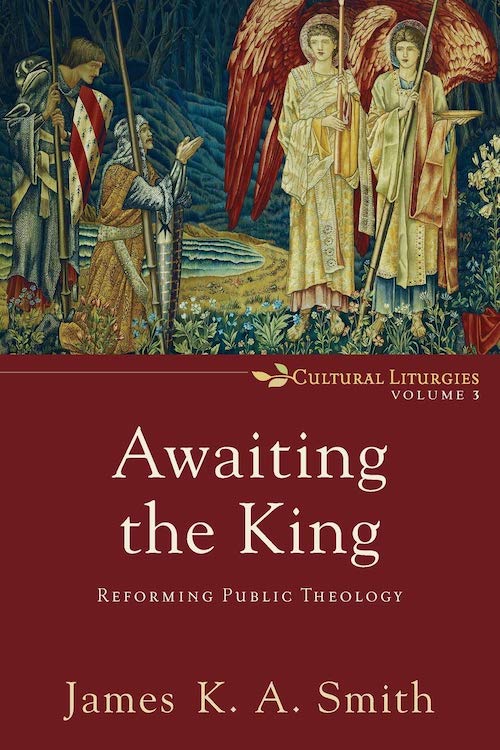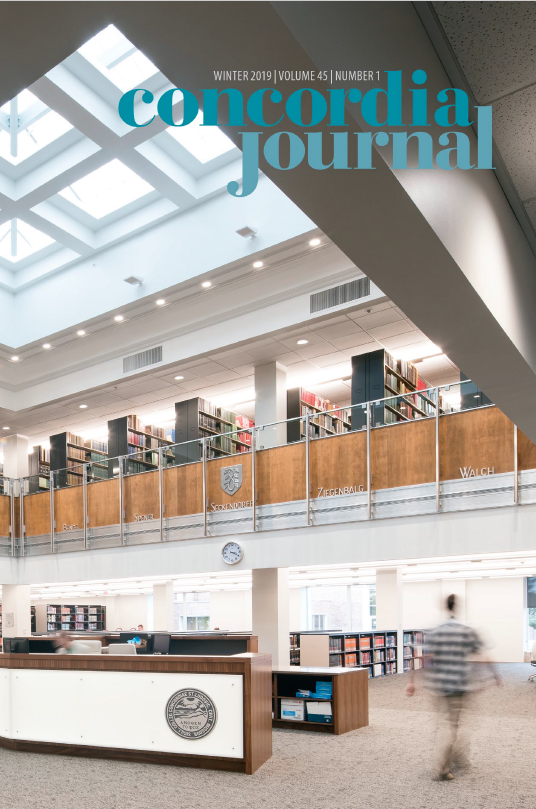Editor’s note: this review originally appeared in the Winter 2019 issue of the Concordia Journal. We reprint it here in anticipation of Dr. Smith’s plenary presentation at this year’s Theological Symposium, September 21-22, 2021. For more information and to register, go to https://www.csl.edu/resources/continuing-education/theological-symposium/.

AWAITING THE KING: Reforming Public Theology. By James K. A. Smith. Baker Academic, 2017. 256 pages. Paper. $22.99.
It took some time before I got around to reading the first two installments of James K. A. Smith’s Cultural Liturgies project. Only after confronting too many references to ignore did I finally pick up Desiring the Kingdom, and then Imagining the Kingdom. In light of those texts, I greeted the arrival of Awaiting the King with genuine anticipation—especially after I saw the subtitle: Reforming Public Theology. I was hooked, and the book vaulted to the top of my reading list.
As expected, Smith provides a carefully crafted and engaging account of the ideas, problems, and arguments that eventually provoked him sufficiently to pull together those disparate threads into a new book. Smith is a pleasure to read for both his content as well as his style. Prose that can describe society as “an archipelago of egoists” (134) is its own reward, but that gift is coupled with the ability to take the esoteric and lofty and make it both accessible (well, mostly) and surprisingly relevant. To follow along as he juxtaposed and eventually connected, whether seamlessly or not, Augustine, Kuyper, Hauerwas, and O’Donovan was enjoyable and educational. But the threads that make up this present book seem a bit more parochial and narrow than those that were woven together in his previous two volumes. While Smith inevitably writes from and for the Calvinist-shaped corner of the faith that formed him, Awaiting the King takes up questions that might fascinate only the most ardent and educated members of that tradition. Whether or not Kuyper is to blame for a version of Christianity that cordons off the sacred from the secular and then too readily accommodates itself to the prevalent culture is not an overwhelming concern of those outside that orbit, I suspect. Still, since that corrupt version of the faith is altogether familiar and uncomfortably recognizable even among believers who wouldn’t know Kuyper from an ottoman at IKEA, the question is more relevant and pressing than it might initially seem. Smith wrestles with the old, perennial, and important problem of how exactly one who is committed to follow Christ is to think about and interact with a world that has a decidedly different orientation.
Smith’s quest for an answer arises from a place and then travels a path that are equally foreign to most Lutheran readers, but when he arrives with more or less certainty at his present location, those same Lutheran readers should feel pleasantly at home. Smith’s moves are not entirely idiosyncratic. His description of the wonderful yet disquieting experience of reading Hauerwas in the context of his own conventional and conservative American Christian upbringing was reassuringly familiar. Having encountered Hauerwas in much the same way, I was not surprised to hear Smith confess that Hauerwas had led him at length not into a tribal retreat from the world but rather directly into the midst of the world. Reading Hauerwas brought me to the same place, and left me with a similar problem. Smith was left to contend with those who twist Augustine and Kuyper to endorse a version of Christianity that would transform the culture via engagement that borders on endorsement coupled with a studied concealment and exclusion of Christ from that engagement. My task has been to confront those who too conveniently would bifurcate their Christian life into hermetically sealed spheres, one spiritual and churchly, the other secular and patriotic, and do it all in the name of Luther.
In the midst of supporting and occasionally distracting topics and texts, it seems that Smith ultimately seeks a church unafraid of the world, but one also that is unafraid to manifest and declare to that world the reality of Christ and his truth that is the sole meaning and hope of the world. Neither as pessimistic about the world and its governments as Hauerwas, nor as sanguine about the prospects of transforming the culture as his own tradition, the interface envisioned by Smith is not far from one that a faithful Lutheran should endorse. Smith moves from a distorted Kuyperian Calvinism through Hauerwas back to Kuyper with a little help from O’Donovan. I move from a misconstrued Lutheranism through Hauerwas back to Luther with a little help from Neuhaus. And when we arrive at the end we are, I would argue, side-by-side in an appeal for a robust church ready to engage the world with God’s truth on multiple levels—well beyond an artificial restriction to things “spiritual.” Smith is right. Through the “formative disciplines and practices” of the church, “God sanctifies our perception so that we can see reality more clearly—that is, in light of revelation and the hope of the world.” So formed, we are sent into the penultimate reality of the culture, “to bear witness to how the world could be otherwise” (224). This, I am convinced, is precisely the task to which Luther would call the church today, and the task that faithful Lutherans should readily shoulder.
There is, obviously, much more that could be said about Smith’s lavish serving of ideas, realities, and truth and their melding in the life of the twenty-first-century church. His thoughtful response to those who would marshal evidence of the church’s failure to form through liturgy, the “Godfather problem” (168), needs to be heard and understood by those who champion a sort of magical effect of rote participation in liturgy. And his drumbeat polemic against “natural law” only persuaded me all the more both of the reality of God’s hardwired will for his creation, and the need for a better moniker. Finally, it would be richly satisfying to engage the author in discussions about both the nuances of law and gospel and what Luther actually taught about issues of church and state . . . perhaps another time. While this final volume of Smith’s Cultural Liturgies project may be different from what has come before, it is a great gift to the church in its own right. In his persistent and persuasive way, Smith compels the reader to rethink much that had been comfortably assumed and to see reality in the church and the world with an enhanced field of vision that is at once wider and more incisive.


Leave a Reply
You must be logged in to post a comment.